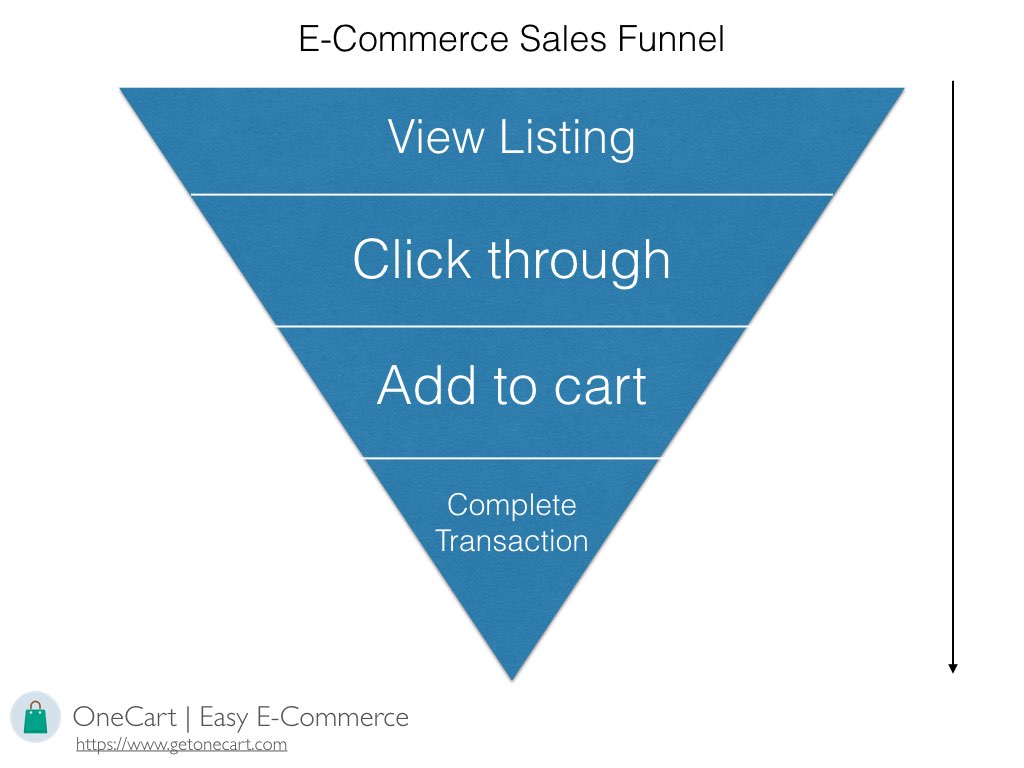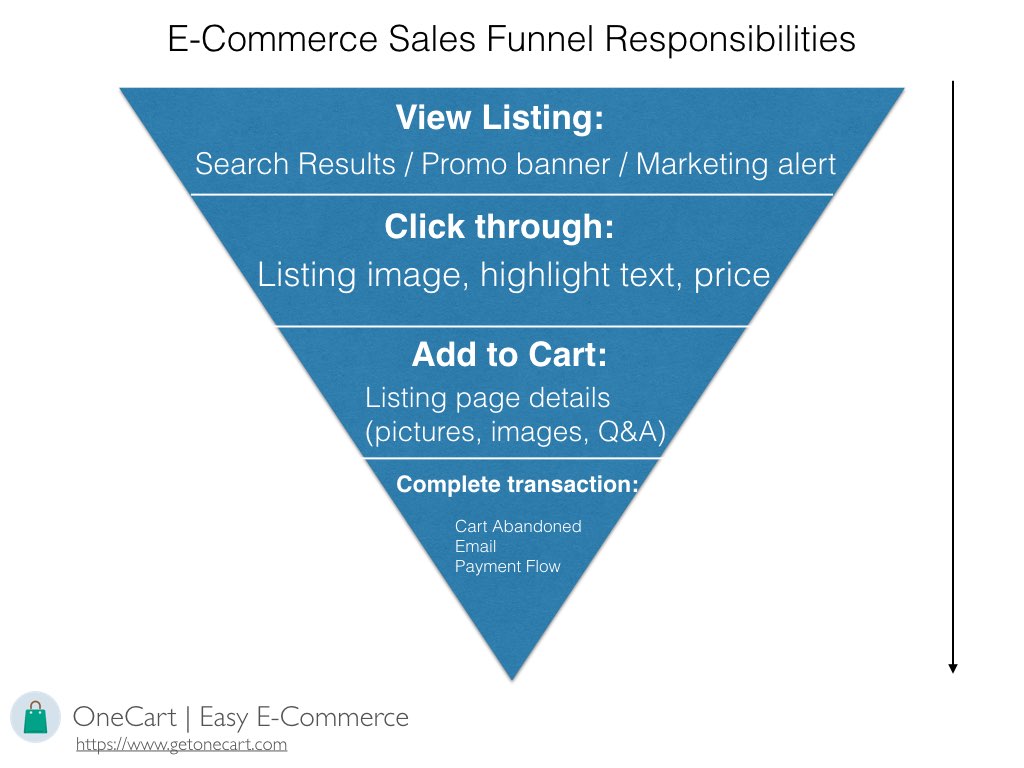Understanding your E-Commerce Sales Funnel

This is a follow-on guide for our previous explainer: What is a sales funnel?. If you’re coming directly to this page, we recommend starting with that guide first, and then returning here.
In a previous guide, we described a Sales Funnel, a concept many businesses use to help them understand and then improve the flow of prospective customers to their business.
Here, we’ll extend the concept to online sales, and learn how your e-commerce operation can be adjusted to increase your sales.
Similar to a physical store sales funnel
While there are many differences from offline when selling online, there is a similar flow for how your customers get introduced to your product before they buy.
- Customers need to first “walk past your store”.
- They need to see your online listing.
- They then need to “stop and look in”, and “enter the shop”.
- They need to pause, and click to view more details about your listing.
- Then, your sales person has to persuade them to buy and potentially upsell them.
- The user needs to understand your listing, and add it to their checkout cart.
- Finally, they need to buy their desired item.
- They need to finish the checkout process and enter their payment details
An image to help visualise:
Let’s modify our previous sales funnel image with what we know about the customer flow online:

Diving in
Let’s explore each stage a little deeper:
1. Customers need to see your online listing
As with offline retail, customers need to see your store and products before they can buy it. But online, where do they come from?
In a mall or offline location, there is often a base number of people who pass your store every day. This foot traffic has been shown to account for up to 70% of sales in offline retail!
Similarly, for e-commerce sales, you need a strategy for getting people to your listing. The strategy may be as simple as “list products on an existing e-commerce platform that has many daily visitors”. In Southeast Asia, this may be Qoo10, or Lazada, or Shopee, or any of the more specialised online retail locations.
If you’re operating your own online store, such as via Shopify or WooCommerce or something else, then you’ll have to drive traffic to that location yourself. The ways to do that is outside the scope of this article, but subscribe below to get notified when we publish that guide.
For this explainer, let’s assume you have listed your products on one of the major e-commerce platforms in your market. They will have a base number of visitors every day, and you can and should ask them for daily visitor information, both for your listings and their site in general.
These platforms often have marketing activities to help boost the visibility of different listings. Digital marketing efforts such as Search Engine Optimization (SEO) are not uncommon. Unlike offline retail, for e-commerce these initiatives are usually the best way to boost visits to your listings.
These marketing activities usually cost some money - check with your category manager at the platform you’re listing on, and do your calculations to make sure you can make a profit if you do participate and get some sales.
2. Clicking into your listing page
Luckily, when selling online it’s much easier to get a potential customer to “enter your store”. A simple click, and they’ve entered!
This click-through rate is determined by the listing preview: what a customer sees on a search results page, or a category browse page. Things that determine this include your cover image, the highlight description, and price as compared to other alternatives on the same page.
The Click-Through is important, as once a customer has “entered”, you can then start persuading them to buy your product.
3. Adding to cart
Earlier, we enjoyed the ease-of-entry of customers when they are browsing online. Unfortunately, this “easy-entry” also allows for “easy-exit” - also known as a bounce rate.
You have one two-dimensional page to convince them to add-to-cart, and not be part of your bounce-rate statistic.
The “Bounce rate” of your listing is the percentage of online viewers who click away from your page and leave.
There are a few ways to improve your bounce rate: You can improve your pictures, text description, product assortment, and modify your price to be more competitive with alternative listings. We’ll do a deeper discussion of this in another article.
With e-commerce, a lot of the buying process is compressed into what the potential customer can see on your listing page. It’s important to trigger that emotional connection and get them to add the product to their shopping cart.
4. Entering payment information
Great, so your listing is optimised, people are visiting and staying on your page, and customers are adding your products into their cart. All done right?
Not so fast: if your customer does not complete the transaction, the sale never occurs. This happens much more frequently than you might think. In fact, if you shop online yourself, you very likely have added items to your cart and just never completed the transaction afterwards.
This metric is known as the cart abandonment rate. It measures how many people add something to their cart, but never finishing checking out.
There are many reasons for this, most common of which is: this is a normal part of online commerce. The internet makes everything so easy, that people just sometimes don’t finish checking out because they got distracted doing something else.
What you can do though, is help nudge people along the way. The most common and effective tactic is a “cart abandoned email”. Shopify has this built into their software, and some of the major e-commerce players do it as well. This is when the customer receives an email gently reminding them that they have items pending checkout.
Note that this is a friendly email, not a demanding one. This also assumes that the customer has provided their contact details before they abandoned the cart. However, good platforms can also perform in-browser/in-app “alerts” or “notifications” if the customer has not provided any contact details just yet.
For the vast majority of cases, people who are doing different things while online shopping simply forget to complete their purchase, and this email or notification is a good way to bring them back into the flow.
Completing the transaction successfully
So now your customer is at the payment screen. As usual however, this is another place in e-commerce where drop-offs are more common than in offline retail.
Major platforms have this solved - they usually accept all payment types (whether it is credit, debit, cash-on-delivery, gift cards, or other digital payment options), and have billing and shipping details worked out.
They can also accommodate One-Time-Password (OTP) SMS confirmations that some banks or cards require.
However, if you’re rolling your own solution, or have configured your Shopify or WooCommerce software incorrectly, you must be aware of how your customers get stuck at this part of the process.
The worst example was a major budget airline in Southeast Asia (we’re not naming it but you have definitely flown on it): They could not accept credit card payments from American/European customers, because their payment system could not handle cards that did NOT ask their consumers for an OTP SMS.
Their system was expecting all credit cards to issue a One-Time-Token SMS to the customer to confirm the transaction, so American & European customers whose cards that did not do that could never complete the transaction on their own.
That is a very silly way to lose business! Luckily for them, this now seems to be resolved.
Another bad example from an online clothing store was that their “Billing Country” dropdown options did not include certain countries, even though their “Shipping Country” dropdown did. So they were able to ship to those countries, but the system could not accept billing addresses from those countries!
And sometimes, the server handling the order transaction chokes, and the customer gets an error as the payment fails. This can also happen often, and only makes customers unhappy with the entire experience, even though you may not have control over that part of the process.
The best way is to see how you can track Payment failures - this is a variation of abandoned carts, whereby the dropoff happens at the payment processing screen, instead of earlier in the process. Knowing this metric (along with the others mentioned above) can help you better understand your e-commerce flow.
Funnel with responsibilities:
Here’s our e-commerce funnel again with the levers you can tweak for each stage:

Metrics to track
To summarise, here are the metrics you should be tracking for every single one of your online listings on a daily basis:
- How many times are people searching for your product category?
- How many views is your listing getting?
- How many page visits?
- How many people are adding your products to their cart?
- What is the cart abandonment rate?
- How many customers get payment failures?
This is all key information, and you must have them in order to effectively improve your e-commerce sales.
Key differences
While there are similarities to the offline sales funnel, an online sales funnel gives you some other benefits, but also potential concerns. To recap:
- In an offline funnel, you see your customer at every step of the process. Online, unless you are tracking the data, they are invisible until they make a purchase.
- Online may provide you more potential customers at the top of the funnel, but it also provides the customers more alternatives to you. It can also be harder to convert them in the funnel.
- It’s easier for you to control the entire buying funnel offline. Online, the platform you are selling on, technical issues, and other factors can prevent a purchase from happening without you knowing it.